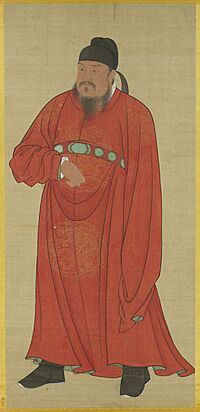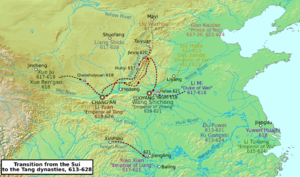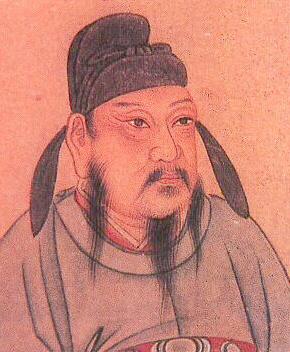Emperor Gaozu of Tang facts for kids
Quick facts for kids Emperor Gaozu of Tang唐高祖 |
|||||||||||||||||
|---|---|---|---|---|---|---|---|---|---|---|---|---|---|---|---|---|---|

Ming dynasty (1368–1644) depiction of Gaozu.
|
|||||||||||||||||
| Emperor of the Tang dynasty | |||||||||||||||||
| Reign | 18 June 618 – 4 September 626 | ||||||||||||||||
| Successor | Emperor Taizong | ||||||||||||||||
| Duke of Tang | |||||||||||||||||
| Tenure | 572 – 618 | ||||||||||||||||
| Predecessor | Li Bing | ||||||||||||||||
| Successor | Incorporated with the crown | ||||||||||||||||
| Retired Emperor of the Tang dynasty | |||||||||||||||||
| Tenure | 4 September 626 – 25 June 635 | ||||||||||||||||
| Born | 7 April 566 Chang'an, Northern Zhou |
||||||||||||||||
| Died | 25 June 635(aged 69) Da'an Palace, Chang'an, Tang dynasty |
||||||||||||||||
| Burial | Xian Mausoleum (獻陵) | ||||||||||||||||
| Consorts | Empress Taimu (m. 581; died 613?) |
||||||||||||||||
| Issue | See § Family | ||||||||||||||||
|
|||||||||||||||||
| House | Li | ||||||||||||||||
| Dynasty | Tang | ||||||||||||||||
| Father | Li Bing | ||||||||||||||||
| Mother | Lady Dugu | ||||||||||||||||
| Tang Gaozu | |||||||||||||||||||||||||||
|---|---|---|---|---|---|---|---|---|---|---|---|---|---|---|---|---|---|---|---|---|---|---|---|---|---|---|---|
| Chinese | 唐高祖 | ||||||||||||||||||||||||||
| Literal meaning | "High Progenitor of the Tang" | ||||||||||||||||||||||||||
|
|||||||||||||||||||||||||||
| Li Yuan | |||||||||||||||||||||||||||
| Traditional Chinese | 李淵 | ||||||||||||||||||||||||||
| Simplified Chinese | 李渊 | ||||||||||||||||||||||||||
| Literal meaning | (personal name) | ||||||||||||||||||||||||||
|
|||||||||||||||||||||||||||
| Shude | |||||||||||||||||||||||||||
| Chinese | 叔德 | ||||||||||||||||||||||||||
| Literal meaning | (courtesy name) | ||||||||||||||||||||||||||
|
|||||||||||||||||||||||||||
Emperor Gaozu of Tang (born Li Yuan) was the very first emperor of the Tang dynasty in China. He ruled from 618 to 626 AD. Before becoming emperor, Li Yuan was a governor in the area of modern-day Shanxi province. He was based in the city of Taiyuan.
In 615, Li Yuan was put in charge of defending the Longxi region. He became very skilled at dealing with the Göktürks from the north, and he managed to keep them peaceful. These successes helped him gain a lot of support. When the Sui dynasty started to fall apart in July 617, Li Yuan decided to rebel. His second son, Li Shimin, encouraged him to do so.
Li Yuan first made a young boy, Yang You, a puppet emperor. But soon, he removed Yang You and started the Tang dynasty in 618, making himself the emperor. After his death, his son Li Shimin honored him with the name Gaozu, which means "high founder."
Emperor Gaozu spent his reign bringing all of China under Tang rule. With the help of Li Shimin, he defeated many other leaders who also wanted to rule. By 628, the Tang dynasty had successfully united all of China. At home, Emperor Gaozu followed many good policies from an earlier emperor, Emperor Wen of Sui. He made sure land was shared fairly and lowered taxes. He also changed the harsh laws and improved the justice system. These changes helped set the stage for his son Emperor Taizong's reign, which was a golden age for the Tang dynasty.
In 626, a big conflict happened between Li Shimin and his older brothers, Li Jiancheng and Li Yuanji. Li Shimin ambushed and killed them at Xuanwu Gate. Because of this, Emperor Gaozu decided to give up his throne to Li Shimin. He became a Taishang Huang (retired emperor) and passed away on June 25, 635.
Contents
Early Life and Rise to Power
Li Yuan came from an important family. His ancestors were officials and generals. His grandfather, Li Hu, was a major general and was given the title Duke of Tang. Li Yuan's father, Li Bing, inherited this title. Li Yuan himself became the Duke of Tang in 572. He kept this title even after the Sui dynasty began in 581, because the Sui emperor's wife was his aunt.
Li Yuan married Lady Dou, who was the daughter of a powerful general. During the reign of Emperor Wen of Sui (581–604), Li Yuan worked as a provincial governor several times. Later, under Emperor Yang of Sui, he became a government minister. In 613, when Emperor Yang fought a war against Goguryeo, Li Yuan helped with supplies. He also led troops during a rebellion, which allowed him to recruit many talented people to his team.
In 615, Li Yuan was put in charge of fighting rebels in the Hedong region. Later, he was given control of the important city of Taiyuan.
The Rebellion Against Emperor Yang
Emperor Yang of Sui became unhappy with Li Yuan. There were also rumors that the next emperor would be named Li, which made Emperor Yang suspicious of anyone named Li. This made Li Yuan worried for his safety.
Many stories say that Li Yuan's son, Li Shimin, was the one who first planned the rebellion. He supposedly convinced his father to rise up. However, some historians now believe that Li Yuan himself started the idea.
Li Yuan began gathering soldiers, saying they were needed to fight against northern invaders. His deputies became suspicious, so Li Yuan had them executed. He secretly called his sons, Li Jiancheng and Li Shimin, to Taiyuan. His daughter, the future Princess Pingyang, also raised her own army to support him. She became a strong leader, gathering 70,000 troops.
Li Yuan officially declared his rebellion. He pretended to still be loyal to the Sui dynasty, saying he only wanted to put Emperor Yang's grandson, Yang You, on the throne. He also made a deal with the northern Turks to get more men and horses. Li Yuan put Li Jiancheng and Li Shimin in charge of his army. They marched south towards the capital, Chang'an.
Li Yuan's daughter, Princess Pingyang, was very successful. She captured several towns and her army grew very large. She later joined forces with Li Shimin. Together, they helped Li Yuan capture Chang'an in the winter of 617. Li Yuan then declared Yang You as the new emperor, but Li Yuan was the real power behind the throne. He became the grand chancellor and was named the Prince of Tang.
Founding the Tang Dynasty and Uniting China
In the spring of 618, Emperor Yang of Sui was killed in a coup. When Li Yuan heard the news, he had Yang You give up the throne to him. This is how the Tang dynasty officially began, with Li Yuan as Emperor Gaozu. He brought back many of the good rules from the first Sui emperor. He made his oldest son, Li Jiancheng, the crown prince. Li Shimin became the Prince of Qin, and Li Yuanji became the Prince of Qi.
Emperor Gaozu immediately faced challenges from other rebel leaders. One major threat was Xue Ju, who called himself the Emperor of Qin. Li Shimin, even though he was sick, defeated Xue Ju's army. After Xue Ju died, Li Shimin forced Xue Rengao, Xue Ju's son, to surrender.
Another powerful leader, Li Mi, joined Emperor Gaozu but later tried to regain his independence. He was ambushed and killed. In 619, another leader, Wang Shichong, started his own state called Zheng. Li Gui, who had also declared himself emperor, was captured and executed by Tang forces. Other rebel leaders like Du Fuwei and Luo Yi also joined the Tang dynasty.
However, the Tang dynasty faced another big threat from Liu Wuzhou. Emperor Gaozu sent Li Shimin to fight Liu. By the summer of 620, Li Shimin had defeated Liu Wuzhou, forcing him to flee. This brought much of northern China under Tang control.
Meanwhile, another powerful leader, Dou Jiande, took over many cities in the north. Li Shimin then began a major campaign against Wang Shichong's Zheng state. He surrounded Wang's capital, Luoyang. Dou Jiande came to help Wang, leading to a big battle at Hulao Pass. In the summer of 621, Li Shimin defeated Dou Jiande and captured him. Wang Shichong then surrendered. This brought most of central China under Tang rule.
After Emperor Gaozu executed Dou Jiande, one of Dou's generals, Liu Heita, rebelled again and took back much of the land. But by 624, Liu Heita was defeated and executed by Li Jiancheng. By this time, China was almost completely united under the Tang dynasty.
The Xuanwu Gate Incident and a New Emperor
As China became more unified, a strong rivalry grew between Li Jiancheng, the crown prince, and Li Shimin. Li Shimin had won many important battles and was very popular with the army. Li Yuanji, another brother, supported Li Jiancheng. The emperor's favored concubines also supported Li Jiancheng, which helped him keep his position as crown prince.
The rivalry became very intense. Li Shimin feared that his brothers would try to kill him. His advisors encouraged him to act first. Li Jiancheng also tried to weaken Li Shimin's power by having his trusted officers removed.
In the summer of 626, the northern Turks attacked again. Emperor Gaozu decided to send Li Yuanji to fight them, giving him control of many soldiers. This worried Li Shimin even more. Li Shimin secretly brought back his trusted advisors. One night, he told Emperor Gaozu that Li Jiancheng and Li Yuanji were disloyal.
The next morning, as Li Jiancheng and Li Yuanji approached the Xuanwu Gate of the palace, Li Shimin ambushed them. Li Shimin personally shot an arrow that killed Li Jiancheng. Then, Li Shimin's general killed Li Yuanji. Li Shimin's forces entered the palace. Under pressure, Emperor Gaozu agreed to make Li Shimin the new crown prince. Li Shimin then accused his dead brothers of treason and had their sons executed. Two months later, Emperor Gaozu gave up his throne to Li Shimin, who became Emperor Taizong.
Life as a Retired Emperor
After giving up the throne, Emperor Gaozu became a retired emperor. He didn't try to control his son's rule much. Emperor Taizong quickly changed some of his father's policies, like reducing the number of imperial princes and releasing many ladies-in-waiting from the palace.
In 629, Emperor Gaozu moved to a different palace called Da'an Palace. This allowed Emperor Taizong to move into the main palace.
In 630, Emperor Gaozu heard that Emperor Taizong's general had defeated and captured the Turkic leader, Jiali Khan. Emperor Gaozu was very happy. He said, "My son can destroy the Turks! I have given the empire to the right person, and I have nothing to worry about!" He then held a big celebration with princes, princesses, and officials, playing music and having everyone dance.
Chang'an could be very hot in the summer. Emperor Taizong often invited his father to a cooler summer palace. However, Emperor Gaozu didn't like that palace. So, in 634, Emperor Taizong started building a new summer palace, Daming Palace, just for his father. But Emperor Gaozu became ill before it was finished and never got to visit it. He passed away in the spring of 635.
Era Name
- Wude (武德 wǔ dé) 618–626
Key Officials During His Reign
Here are some of the important officials who served Emperor Gaozu:
- Li Shimin (618–626)
- Pei Ji (618–626)
- Xiao Yu (618–626)
- Chen Shuda (618–626)
- Feng Deyi (620–626)
- Yuwen Shiji (625–626)
- Gao Shilian (626)
- Fang Xuanling (626)
Family
Emperor Gaozu had many children with his wife and other consorts.
- His main wife was Empress Taimu, of the Dou clan (died 613). They had:
- Li Jiancheng, the Crown Prince (589–626), his first son.
- Princess Zhao of Pingyang (died 623), his third daughter. She was a brave leader who raised her own army.
- Li Shimin, who became Emperor Taizong (598–649), his second son.
- Li Xuanba, Prince Weihuai (599–614), his third son.
- Li Yuanji, Prince Chaola (603–626), his fourth son.
- He also had many other sons and daughters with different consorts, including:
- Li Zhiyun, Prince Chu'ai (604–617), his fifth son.
- Li Yuanheng, Prince Fengdao (619–632), his eighth son.
- Li Yuanjia, Prince Han (620–688), his 11th son.
- Li Lingkui, Prince Lu (625–688), his 19th son.
- Li Yuanjing, Prince Jing (618–653), his sixth son.
- Li Yuanchang, Prince Han (619–643), his seventh son.
- Li Yuanyu, Prince Dengkang (624–665), his 17th son.
- Li Yuanxiang, Prince Jiang'an (626–680), his 20th son.
- Li Yuanming, Prince Shu (624–689), his 18th son.
- Li Yuanfang, Prince Zhou (619–629), his ninth son.
- Li Yuanli, Prince Xukang (619–672), his tenth son.
- Li Yuanqing, Prince Daoxiao (623–664), his 16th son.
- Li Yuangui, Prince Huo (622–688), his 14th son.
- Li Feng, Prince Guozhuang (622–675), his 15th son.
- Li Yuanze, Prince Pengsi (620–651), his 12th son.
- Li Yuanxiao, Prince Mizhen (628–676), his 21st son.
- Li Yuanyi, Prince Zhenghui (621–673), his 13th son.
- Li Yuanying, Prince Teng (630–684), his 22nd son.
- His daughters included:
- Princess Changsha, his first daughter.
- Princess Xiangyang, his second daughter.
- Princess Gaomi, his fourth daughter.
- Princess Changguang, his fifth daughter.
- Princess Fangling (619–673), his sixth daughter.
- Princess Changle (died 688), his seventh daughter.
- Princess Jiujiang, his eighth daughter.
- Princess Luling, his ninth daughter.
- Princess Nanchang, his tenth daughter.
- Princess Anping, his 11th daughter.
- Princess Huainan (622–690), his 12th daughter.
- Princess Zhending, his 13th daughter.
- Princess Hengyang (622–690), his 14th daughter.
- Princess Danyang, his 15th daughter.
- Princess Linhai, his 16th daughter.
- Princess Guantao, his 17th daughter.
- Princess Changsha (died 724), his 18th daughter.
- Princess Anding, his 19th daughter.
Images for kids








